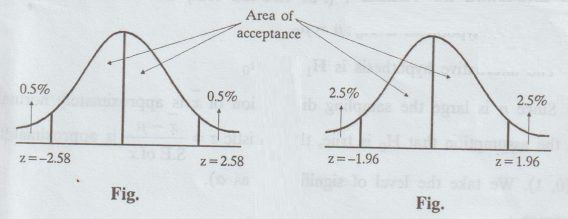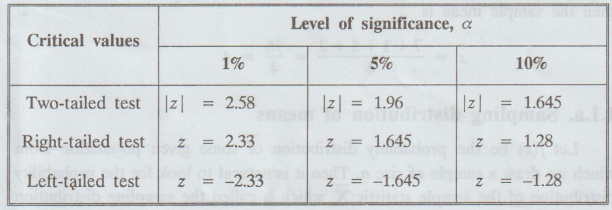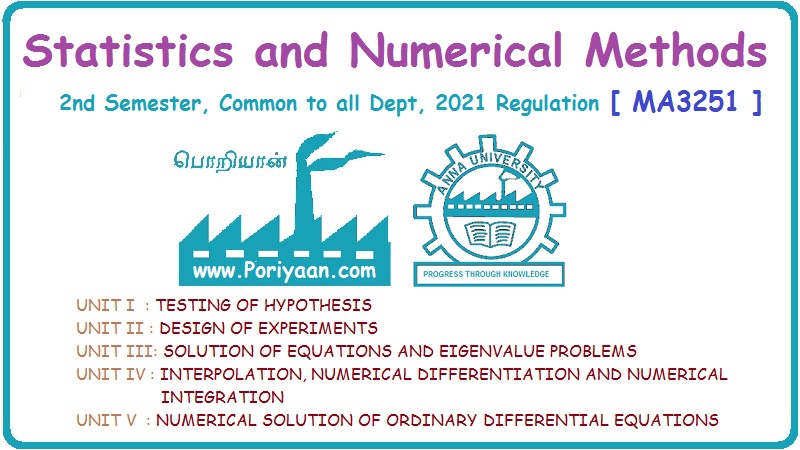Statistics and Numerical Methods: Unit I: Testing of Hypothesis
Testing of Hypothesis
Many problems in engineering require that we decide whether to accept or reject a statement about some parameter. The statement is called a hypothesis and the decision-making procedure about the hypothesis is called hypothesis testing.
UNIT
– I
Chapter
- 1
TESTING
OF HYPOTHESIS
Introduction
Many
problems in engineering require that we decide whether to accept or reject a
statement about some parameter. The statement is called a hypothesis and the
decision-making procedure about the hypothesis is called hypothesis testing.
This is one of the most useful aspects of statistical inference, since many
types of decision making problems, tests, or experiments in the engineering
world can be formulated as hypothesis-testing problems. Furthermore, as we will
see, there is a very close connection between hypothesis testing and confidence
intervals. Statistical hypothesis testing and confidence interval estimation of
parameters are the fundamental methods used in the data analysis stage of a comparative
experiment.
Before
giving the notion of sampling, we will first define population.
(a) Population
A population in statistics means a set of objects or mainly the set of numbers which are measurements or observations pertaining to the objects. The population is finite or infinite according to the number of elements of the set is finite or infinite.
(b) Sampling
A
part selected from the population is called a sample. The process of selection
of a sample is called sampling.
(c) Random sampling
A
Random sampling is one in which each number of population has an equal chance
of being included in it. There are NCn different samples of size n
that can be picked up from a population size N.
(d) Parameters and statistics
The
statistical constants of the population, such as mean (µ), standard deviation
(σ) are called parameters.
Parameters
are denoted by Greek letters.
The
mean x, standard deviation S of a sample are known as statistics. Statistics
are denoted by Roman letters.
(e) Symbols for population and samples

(f) Aims of a sample
The
population parameters are not known generally. Then, the sample characteristics
are utilised to approximately determine or estimate the population. Thus,
statistic is an estimate of the parameter. The estimate of mean and standard
deviation of the population is a primary purpose of all scientific
experimentation. The logic of the sampling theory is the logic of induction. In
induction, we pass from a particular (sample) to general (population). This type
of generalization here is known as statistical inference. The conclusion in the
sampling studies are based not on certainties but on probabilities.
(g) Types of sampling
(1)
Purposive sampling, (2) Random sampling, (3) Stratified sampling and (4) Systematic
sampling.
(h) Sampling distribution
From
a population, a number of samples are drawn of equal size n. Find out the me
mean of each sample. The means of samples are not equal. The means with their
respective frequencies are grouped. do algse 15llib On T The frequency
distribution so formed is known as sampling distribution of the mean.
Similarly, sampling distribution of standard deviation can be had.
(i) Standard error (S.E)
S.E
is the standard deviation of the sampling distribution. For assessing the
difference between the expected value and observed value, standard error is
used.
Reciprocal
of standard error is known as precision

If
i is any statistic, for large samples Z = t – E (t) / S.E (t) is normaly
distributed is normaly distributed with mean zero and variance unity.
i.e.,
Z = t – E (t) / S.E. (t) – N (0,1)
(j) Tests of significance
An
important aspect of the sampling theory is to study the test of significance,
which will enable us to decide, on the basis of the results of the samples,
whether
(i)
the deviation between the observed sample statistic and the hypothetical
parameter value or
(ii)
the deviation between two sample statics is significant or might be attributed
due to chance or the fluctuations of the sampling.
If
n is large, all the distributions like Binomial, Poisson, Chi-square, t
distribution, F distribution can be approximated by a normal curve.
(k) Testing a hypothesis [A.U
CBT N/D 2011]
On
the basis of sample information, we make certain decisions about the
population. In taking such decisions, we make certain assumptions. These
assumptions are known as statistical hypothesis. There hypothesis are tested.
Assuming
the hypothesis is correct, we calculate the probability of getting the observed
sample. If this probability is less than a certain assigned value, the
hypothesis is to be accepted, otherwise rejected.
(l) Null hypothesis [H0]
Null
hypothesis is based on analysing the problem.
Null
hypothesis is the hypothesis of no difference.
Thus,
we shall presume that there is no significant difference between the observed
value and expected value.
Then,
we shall test whether, then this hypothesis is satisfied by the data or not.
If
the hypothesis is not approved, then the difference is considered to be
significant.
If
the hypothesis is approved, then the difference would be attributed to sampling
fluctuation.
Note:
Null hypothesis is denoted by H0.
(m) Alternative Hypothesis (H1)
Any
hypothesis which is complementary to the null hypothesis (H0) is called
an alternative hypothesis, denoted by H1
Rule
(i)
If we want to test the significance of the difference between a statistic and
the parameter or between two sample statistics, then we set up the to null
hypothesis that the difference is not significant.
This
means that the difference is just due to fluctuations of sampling H0:
μ = x.
(ii) If we want to test any statement about
the population, then we set up the null hypothesis that it is true. For
example, when we want to find, if the population mean has specified value uo,
then we set up the null hypothesis H0μ = μ0
(iii)
Suppose, we want to test the null hypothesis that the population has a
specified mean μo, that is,
H0
: μ = µ0, then the alternative hypothesis will be
(i)
H1 : μ ≠ µ0 i.e., μ > µ0 or μ < µ0
(ii)
H1: μ > µ0
(iii)
H1: μ < µ0
H1
in (i) is called a two-tailed alternative hypothesis
H1
in (ii) is called a right-tailed alternative hypothesis
H1
in (iii) is called a left-tailed alternative hypothesis
One
has to set the alternative hypothesis clearly so that it will help us to decide
to use a single - tailed (right or left) or two-tailed test.
(n) Critical region [A.U
Tvli. M/J 2011] [A.U N/D 2017 R-8]
A
region, corresponding to a statistic t, in the sample space S which amounts to
rejection of the null hypothesis Ho is called as critical region or region of
rejection.
The
region of the sample space S which amounts to the acceptance of Ho is called
acceptance region.
(o) Critical value or significant value
The
value of the test statistic which separates the critical region from the
acceptance region is called the critical value or significant value.
(p) Level of significance [A.U. N/D 2013]
The
probability that the value of the statistic lies in the critical region is
called the level of significance.
In
general, these levels are chosen as 0.01 or 0.05, called 1% level and 5% level
of significance respectively.

(q) Errors [A.U N/D 2011, A.U CBT A/M 2011] [A.U A/M 2015 R-8] [A.U M/J 2016 (R13)]
In
sampling theory to draw valid inferences about the population parameter on the
basis of the sample results, we decide to accept or to reject Ho after
examining a sample from it. To av
Type
I Error: If H0 is rejected, while it should have
been accepted.
Type
II Error: If H0 is accepted, while it should have
been rejected.

(r) Large Sample Tests
Now
we consider the following tests, under large sample test.
1.
Test for a specified mean
2.
Test for the equality of two means
3.
Test for specified proportionatel
4.
Test for equality of two proportions
(s) Test for a specified mean
A
random sample of size n (n ≥ 30) is drawn from a population.
We
want to test that the population mean has a specified value Mo
(t) Procedure for Testing (For two-tail test)
The
null hypothesis is H0 : μ = μ0
The
alternative hypothesis is H1 : μ ≠ μ0
Since
n is large the sampling distribution of ![]() is approximately normal.
is approximately normal.
(on
the assumption that H0 is true, the statistic z =  is
approximately N (0, 1). We take the level of significance as ɑ).
is
approximately N (0, 1). We take the level of significance as ɑ).
Inference:
For
a significance level a = 0.05 (5% level) if |z| < 1.96, H0 is
accepted at 5% level.
If
|z| > 1.96, H0 is rejected at 5% level
For
ɑ = 0.01 (1% level of significance)
if
|z| < 2.58, H0 is accepted
at 1% level of significance.
if
|z| > 2.58, H0 is rejected at 1% level of significance.
(u) Procedure for one-tailed test (left-tail)
(i)
H0 : μ ≥ μ0
H1:
μ < μ0 (left-tailed)
At
ɑ : 0.05 the critical value
of
|z |= 1.645
If
z <-1.645, H0 is rejected
If
z > -1.645, H0 is accepted
At
ɑ = 0.01, the critical value of z is 2.33

(ii)
One-tailed test (right-tailed)
If
z < 1.645, H0 is accepted.
z
> 1.645, H0 is rejected.

In
all these cases, the test we apply, is called z-test.
(v) Table for critical values on using the normal probability

(w) Confidence limits
If
a sample statistics lies in the interval
(µ
- 1.96 σ, μ+ 1.96 σ), we call 95% confidence interval.
Similarly,
Confidence limits as the area between μ - 2.58 σ and μ + 2.58 σ is 99%.
The
numbers 1.96, 2.58 are called confidence co-efficients.
Statistics and Numerical Methods: Unit I: Testing of Hypothesis : Tag: : - Testing of Hypothesis
Related Topics
Related Subjects
Statistics and Numerical Methods
MA3251 2nd Semester 2021 Regulation M2 Engineering Mathematics 2 | 2nd Semester Common to all Dept 2021 Regulation
